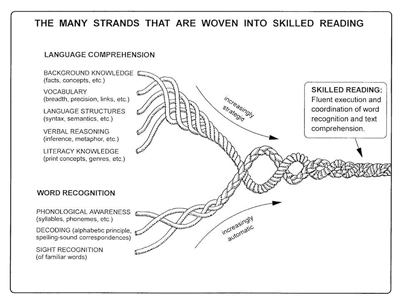You are here
4.2 A Brief Overview of the Science of Reading
Reading is complex and reading research is even more complex. Renowned cognitive neuropsychologist and psycholinguist Mark Seidenberg helps the non-researcher develop a beginning understanding of what reading research has accomplished (Language at the Speed of Sight, 2017):
We understand the basic mechanisms that support skilled reading, how reading skill is acquired, and the main causes of reading impairments.
We know which behaviors of three- and four-year-olds predict later reading ability.
We know how children become readers during the first years of schooling and the obstacles that many encounter.
We know what distinguishes good from poor readers, younger from older skilled readers, and typical readers from those who are atypical because of constitutional factors (such as hearing or learning impairment) or environmental ones (such as inadequate instruction or poverty).
We understand what is universal about reading (things that all readers do the same way because their brains are essentially alike) and what is not (because writing systems differ).
We have identified the main neural circuits involved in reading and some of the anomalous ways they develop in children with reading impairments.
We even have computational models of learning to read, skilled reading, dyslexic reading, and the loss of reading ability due to brain injury.
This vast research has led to the development of methods that can reliably help many children who struggle to read.
Gough and Tunmer in 1986 and Gough and Hoover in 1990 described reading comprehension as the product of decoding (word recognition) and language comprehension. Their model, referred to as the “Simple View of Reading,” is represented by the formula below:
Decoding (D) X Language Comprehension (LC) = Reading Comprehension (RC)
Later, at the start of this millennium, Hollis Scarborough, another leading researcher, expanded on the “Simple View of Reading” and created a graphic representation of reading as a multi-faceted skill that is gradually acquired through many years of instruction and practice. Scarborough’s Reading Rope (2001) demonstrates how the subskills that comprise word recognition and language comprehension work in tandem and allow students to read fluently and coordinate automatic word recognition with text comprehension. This groundbreaking infographic continues to inform the design and delivery of effective reading instruction.
As a result of Gough’s, Scarborough’s, and others’ continuing research, the formula for the “Simple View of Reading” is currently most typically represented as:
WR (Word Recognition) x LC (Language Comprehension) = RC (Reading Comprehension).
Having trouble with this webpage?
If you have problems with broken links or accessing the content on this page, please contact the Exceptional Student Services Unit at ESSU@cde.state.co.us. Please copy the URL link for this page into the email when referencing the problem you are experiencing.





Connect With Us





